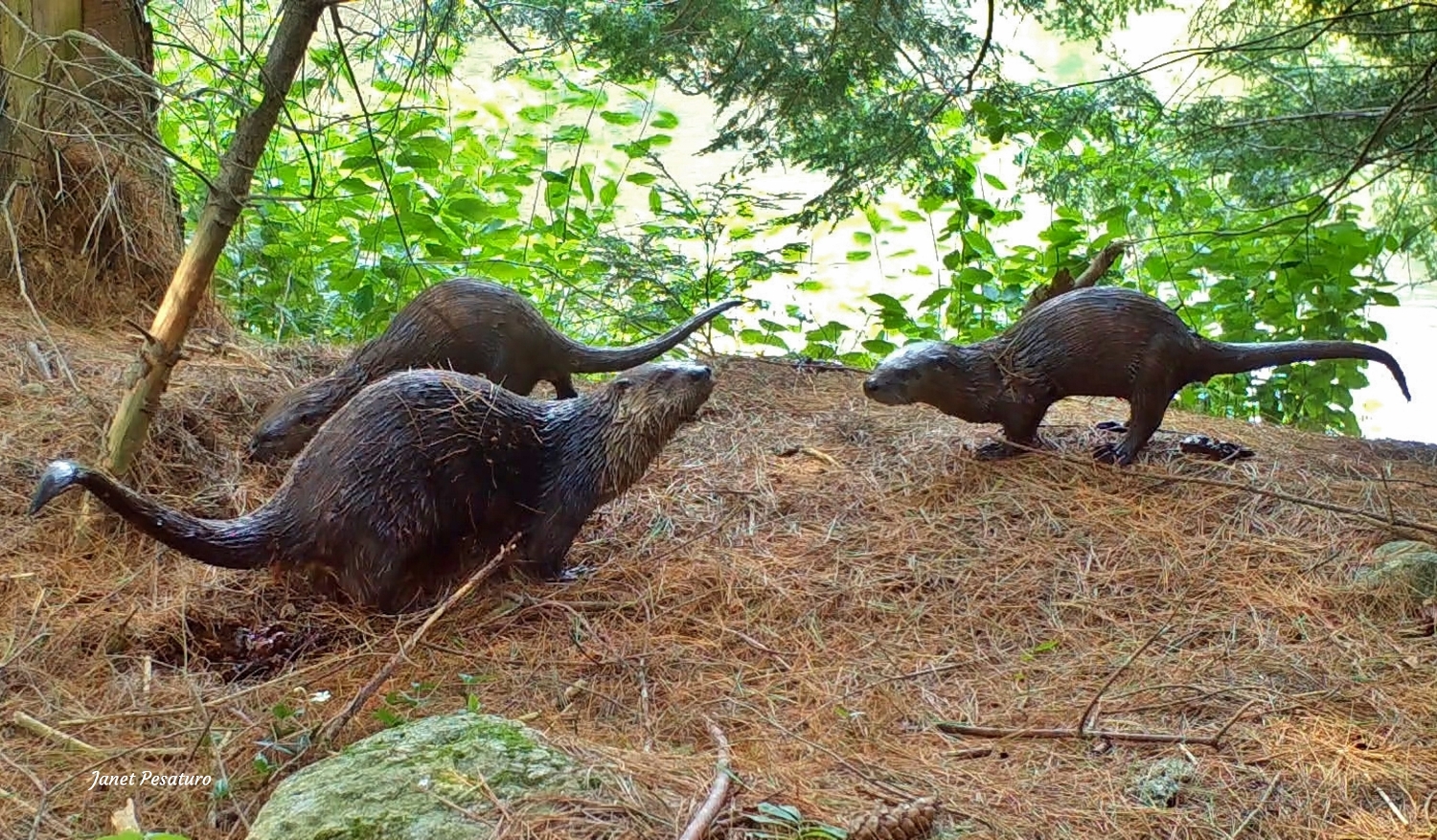River Otter Toilet Training?

Recently I got footage of otter families (Lontra canadensis) at two different locations, and in each case the mother does the “poop dance” (also called “latrine dance”) but her kits do not. It made me wonder what juveniles might learn about scent marking from their mother, and what it might mean about the purpose of otter latrines. Is there such a thing as river otter toilet training, or is this behavior all innate?
The Videos
At an established otter latrine
The first video was captured at an established latrine, the intended camera target. Watch the video and notice that there are two instances in July of a mother indulging in the usual “poop dance” — scraping up a mound with front paws, then eliminating on the mound. In each instance, her two kits watch her and inspect the fruits of her labor but neither kit emulates her behavior. These otters were not the only ones to use the latrine. Not shown in the video are some clips of adult otters visiting the latrine, sometimes in small groups, and sometimes singly. As I said, this was an established latrine where otters had been performing their ritual before the appearance of this family.
At a spot not previously used as a latrine
The next video also features a mother and two kits, but this time the camera target was a newly constructed beaver dam. There was no established otter latrine on the dam, and this mother is the only otter the camera captured scatting on the dam while the camera was in place starting April 23rd, shortly after dam construction. The kits do not display the latrine dance, but nor do they pay much attention to mom’s elimination ritual. Notice that in this case the action takes place in June, so these kits may be younger than those in the first video – could that account for their lack of interest in their mother’s latrine dance?
What Do Young Otters Learn About Latrines from Mom?
If only we could know. While it’s hard for me to imagine that the latrine dance is learned behavior, I was struck by the fact that the kits in the first video seemed to study mom’s behavior and examine her excrement. Perhaps observation serves to induce or refine the development of latrine behavior in the kits? Maybe sniffing her scat and urine within a latrine used by other adults sharpens their ability to distinguish her odor from that of others? Maybe they are also learning to recognize by scent the other otters who use the latrines in the area? As adults, females are usually with their offspring for most of the year, males usually form social groups, and all will eventually want to find mates, so learning learning the identity of otters by their odor at latrines would be useful information for the kits.
Does this Add to Our Understanding of Otter Latrines?
The purpose of otter latrines has been the subject of debate. Some believe the purpose is mutual avoidance between groups; others have suggested that latrine behavior helps strengthen bonds between group members. Both may be important functions, but probably not the only ones because an oft observed pattern is that otter latrine activity peaks in spring and again to a lesser degree in fall. Neither mutual avoidance nor group bonding explains that pattern.
Another possible purpose of otter latrines relates mostly to breeding: communication of breeding condition, social status, and location. That would explain the peak in spring (their mating season) but not the smaller fall peak. To explain the fall peak, some have suggested that perhaps fall is when young of the year begin scatting and urinating in latrines. However, there is no clear evidence of that (to my knowledge). To prove that, we’d need evidence that young do not eliminate at latrines in summer and do begin to use them in fall.
Olson et al. placed cameras at two latrine sites in north central Pennsylvania and noted young first appeared at them with their mothers in late June and continued to accompany her at latrines through fall. They suggested that this lends support to the idea that the juveniles contribute to the increased scenting at latrines in fall. However, they did not report whether there was any evidence of the young eliminating at latrines in summer or fall. They obtained only still images, which might not have allowed them to observe behavior.
My videos do lend a bit of support to the idea that young of the year do not eliminate in latrines in summer. I hope for some fall footage of these families, but as the kits grow, it may be difficult to distinguish family groups from adult groups. We shall see.
Sources
Olson, Z. H., S. S. Stevens and T. L. Serfass. “Do Juvenile Nearctic River Otters (Lontra canadensis) Contribute to Fall Scent Marking?” The Canadian Field-Naturalist. 119 (2005): 457-459.
Related Posts
Feel free to share your questions, thoughts, or knowledge about otters and otter latrines in the comment section below.

I think you posts are amazing. Each time, I learn something new about natural behaviors in mammals. It must be rewarding to live in an area so rich in subjects for your trail cameras.
Thank you! Comments like yours make it worthwhile.